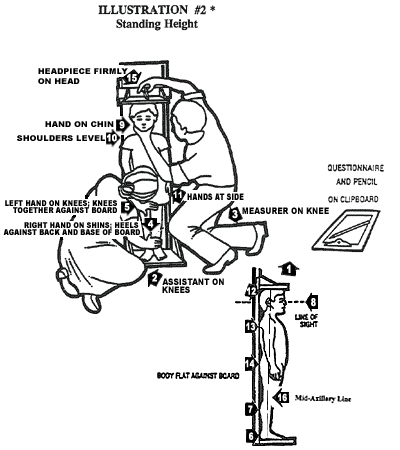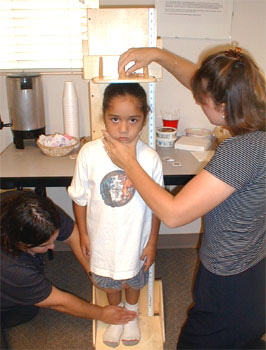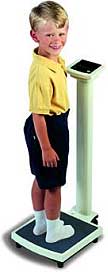Child Guidelines
Measuring Height in Children and Adolescents
Standing height is used to measure children who are more than two years old and can stand without assistance.
Procedures for Taking Standing Height
(Adapted from How To Weigh and Measure Children, I.J. Shorr, UN, New York, 1986)Two people are required to take the standing height of a child under the age of six. The directions below can also be followed for older children except that the child can be instructed on how to position the body and head and does not require anyone to hold the knees and ankles. Children should be measured without shoes and heavy outer clothing such as sweaters and coats.
- Ask the Assistant to remove socks and shoes on the child and remove or push aside any barrettes, braids, or hairstyles that might interfere with the measurement. Big hairstyles will need to be flattened as much as possible.
- Measurer: Provide a brief training to the Assistant on how to hold the child's knees and feet.
- Assistant: Ask the Assistant to walk the child to the board and kneel on the right side of the child. (Arrow 2)
- Measurer: Place the data collection sheet and pen/pencil on the floor near you and kneel on the left side of the child. (Arrow 3)
- Measurer: Place the child's feet flat and either the knees or feet together in the center of the measuring board.
- Assistant: Ask the Assistant to place her/his right hand just above the child's ankles on the shins (Arrow 4) and place her left hand on the child's knees (Arrow 5) and push against the board. Make sure that the child's legs are straight.
The position of the legs is important. The line that bisects the body from the side is called the "mid-axillary line." Make sure the mid-axillary line is perpendicular to the base of the board (Arrow 16). This may mean that the child's feet may not touch the back of the measuring board, particularly in overweight or obese children. - Measurer: Tell the child to look straight ahead. Make sure the child's line of sight (Frankfort Plane) is level with the floor (Arrow 8). The line from the hole in the ear to the bottom of the eye socket (Frankfort Plane) should be perpendicular to the board or table. In overweight, obese and older children, when the head is placed in proper position, according to the Frankfort Plane, there will be a space between the back of the child's head and the back of the measuring board. Do not judge the position of the child's head by looking at the top of the head, use the Frankfort Plane. Place your open left hand on the child's chin. Gradually close your hand (Arrow 9). Do not cover the child's mouth or ears. Do not rest your left hand on the child's chest. Make sure that the shoulders are level (Arrow 10), the hands are at the child's side (Arrow 11) and the head, shoulder blades and buttocks are against the board, if appropriate (Arrows 12, 13 and 14). With your right hand, lower the headpiece on top of the child's head. Make sure that you push through the child's hair (Arrow 15).
- Measurer: When the child's position is correct, read and call out the measurement to 1/8 inch. Continue calling out the measurement.
- Measurer: Record the measurement on the data collection sheet under "Standing Height". Check to make sure it is accurate and legible.
- Measurer: If there were any unusual problems such as braids in the way or difficulty measuring the child, record this next to the measurement on the sheet.
Note: It is acceptable to take two measurements that agree within ¼" and use either one of those measurements.

Illustration No.2 from: How To Weigh and Measure Children, I.J. Shorr, UN, New York, 1986
Common Measurement Errors
-
Improper equipment used.

- Equipment is not properly installed.
- Footwear, heavy outer clothing, hats or hair barrettes are not removed.
- Feet are not flat on floor.
- Knees are bent.
- Head is not in proper position.
- Measurement is not read at eye level.
Weighing Children and Adolescents
Procedure for Taking the Weight of Children and Adolescents Using a Beam Balance Scale
(Adapted from Training Manual for the New York State Child Growth Monitoring Project, I.J. Shorr, 1994-96.)- Place both the sliding beam weights directly over their respective zeroes.
- Loosen the screw on the adjustable zeroing weight or counter weight. Move it until the beam balances, then tighten the screw on the counter-weight.
- Ask the child or Assistant to remove shoes and any heavy clothing such as jackets, sweatshirts, sweaters, etc.
- Ask the child to step onto the scale. Make sure the child is centered on the platform and the arms are at his/her side.
- Move the large 50-pound weight until you find the first notch where the beam falls, then move the weight back one notch.
- Slowly push the small pound weight across the beam until it is balanced. You may need to move it back and forth in small increments several times to reach balance.
- Read and call out the measurement to the nearest 1/4 pound. Call out the weight repeatedly until it is recorded.
(Out of respect for children's privacy, call out weight so other children are not able to hear.) - Record the weight on the data collection sheet. Make sure it is accurate and legible.
- Have the child step off of the scale and return the weights on the beam to zero in preparation for the next measurement. Note: It is acceptable to take two measurements that agree within ¼ lb and use either one of those measurements.
Procedure for Taking the Weight of Children and Adolescents Using a Digital Scale
(From I.J. Shorr, 1997)- Activate the scale by turning it on. Zeroes will appear on the display panel. Make sure the scale is on "lb" rather than "kg".
- Ask the Assistant or child to remove shoes and any heavy clothing such as jackets, sweatshirts, sweaters, etc.
- Ask the child to step onto the scale. Make sure the child is centered on the platform and the arms are at his/her side.
- The weight will appear on the display panel. If the weight changes (e.g. from 22.1 lb to 22.2 lb), record either number. Call out the weight to the nearest ¼ lb repeatedly until it is recorded. (Out of respect for children's privacy, call out weight so other children are not able to hear.)
- Record the weight on the data collection sheet. Make sure it is accurate and legible.
Note: It is acceptable to take two measurements that agree within ¼ lb and use either one of those measurements.
Common Errors
-
Improper equipment is used.

- Scale is not properly zeroed or balanced.
- Footwear and heavy outer clothing are not removed.
- Individual is not properly centered on scale platform.
- Child is holding onto Assistant or scale.
- Child is not remaining still on the scale.


